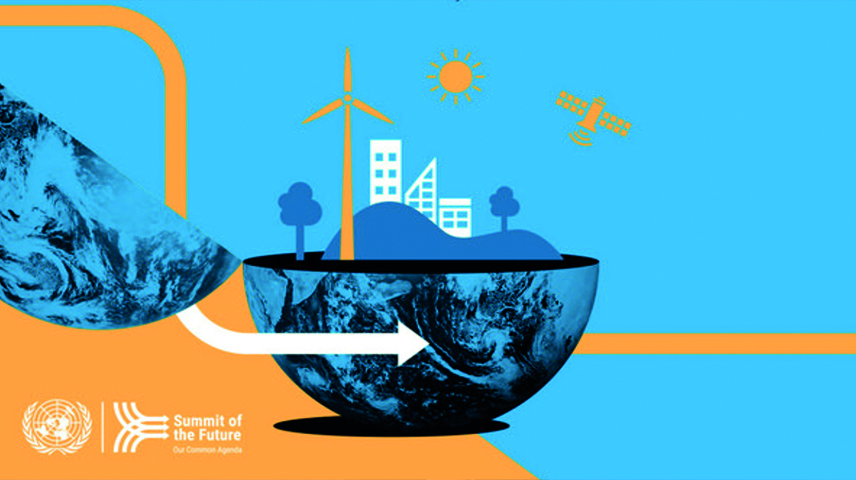As the world teeters on the brink of a profound crisis, the United Nations stands poised to embark on a bold new chapter. The twin challenges of a fractured Security Council and the widening gap between the lofty promises of the Sustainable Development Goals—and their tangible realization—have cast a long shadow over the international system. Yet, amidst this gloom, the Summit for the Future offers a glimmer of hope. Scheduled for the final week of September, this global gathering aims to revitalize multilateralism, address the system's shortcomings, and chart a course toward a more just and equitable future.
Coping with the Limitations of the Global System
Following the high-level meetings of the General Assembly in the latter part of September, the United Nations will host a global summit to confront the shortcomings of the international order. Recent crises have starkly exposed the system's inability to achieve the Sustainable Development Goals and the Security Council's deep divisions. The war in the Gaza Strip and the war in Ukraine serve as poignant examples of this failure, underscoring the international system's inability to build a framework that upholds justice and protects the right to self-determination.
1. New ambitions:
The Summit seeks to secure new pledges to revitalize the 2030 Agenda. Adopted by the world's nations in 2015, this agenda serves as a blueprint for peace and prosperity, outlined in the 17 Sustainable Development Goals. The UN document addresses pressing issues, including poverty, gender inequality, education, and infrastructure.
In his Common Agenda report of December 2021, United Nations Secretary-General António Guterres called for the Summit for the Future in response to member states' desire for a visionary outlook. Guterres emphasized that such global summits are rare opportunities to revitalize international action, reaffirm fundamental principles, and modernize multilateral frameworks. The Summit's organizers hope to revive multilateralism to better equip the world to confront emerging challenges, especially given the international community's faltering progress towards the Sustainable Development Goals.
2. Exposing double standards:
The United Nations Secretary-General has repeatedly criticized the global system, expressing deep frustration over the violation of international law during the war on the Gaza Strip and the international community's failure to halt aggression against defenseless Palestinian civilians. In a May conference in Nairobi, Guterres acknowledged that global crises necessitate global solutions, but the international system is currently incapable of rising to this challenge. He further highlighted the international financial system's unjust, dysfunctional, and outdated nature.
Resuscitating a Dying Multilateralism
1. Breaking cycles of injustice:
The inception of a comprehensive development strategy, both internationally and locally, is hindered by several factors. Notably, major powers and global financial institutions have exhibited extreme hypocrisy in their dealings with the debts of poor countries. Initiatives and mechanisms for debt reduction are inadequate, trapping countries in a seemingly endless cycle of debt interest payments and excessive debt service. Moreover, the underrepresentation of developing countries in international organizations and the marginalization of global civil society amid these crises and disturbances contribute to an incomplete portrayal of the issues affecting these communities. To address these shortcomings, the active parties preparing for the new global summit are focusing on reviving multilateralism.
2. “Pact for the Future”:
Governments and organizations involved in the preparations are circulating three documents to be issued by the Summit for the Future in September. These documents represent the culmination of 18 months of discussions initiated by Guterres in February 2023. The ongoing drafting process of the so-called "pact for the future" reflects the hope that this agreement will serve as a turning point for restoring multilateralism's vitality. Such revitalization would enable the international community to effectively manage risks and seize opportunities, safeguarding humanity from the abyss towards which it is headed.
Proposed ideas include establishing an "emergency platform" for swift responses to crises and adopting a "new agenda for peace" to proactively prevent conflicts. International discussions on these issues underscore the deep-rooted crisis within the international system that hinders the world organization's effectiveness.
3. Advancing sustainability:
Also, the Summit offers a critical opportunity to address the pressing issue of climate change. By reinforcing international commitments, mobilizing financial resources, promoting technology transfer, building resilience, and addressing climate justice, the summit aims to accelerate global action on climate change. The expected outcomes of the summit include enhanced international cooperation, ambitious climate targets, increased financial commitments, accelerated technology transfer, and strengthened resilience and adaptation. By fostering a renewed sense of global solidarity and taking concrete steps to address the challenges of climate change, the summit can help to secure a more sustainable and equitable future for all.
Looking Ahead: Youth Inclusion
Crucial to the ongoing discussions is exploring how to integrate new generations into the pursuit of a future for international multilateralism and involve them in major decision-making processes. One working paper proposes steps to ensure that intergenerational solidarity becomes a guiding principle for sustainable development and the renewal of the multilateral system. The philosophy of integrating new generations at the heart of sustainable development is rooted in the Brundtland Report of 1987, which defined sustainable development as "development that meets the needs of the present without compromising the ability of future generations to meet their own needs."
Current generations bear a significant responsibility. They must temper their ambitions to align with their obligations to future generations, and all efforts towards a better future should prioritize the interests of those to come.
In conclusion, the Summit for the Future presents a crucial opportunity for world leaders to construct a comprehensive and inclusive model that addresses comprehensive development, diversity, human rights, climate, and the rights of future generations. As conflicts escalate, inequality widens, and poverty spreads, threatening humanity's future, the Summit offers a glimmer of hope for real solutions and a renewed sense of optimism.


